



Most of us often dream of making something out of our passions even as we remain stuck in the grind of jobs and life situations. Very few are able to cross that bridge and become so iconic that generations after they are gone, few can match their level of popularity. Punjab’s iconic folk singer Amar Singh Chamkila was one such artiste. As yet another biopic on the legendary singer is ready for release, Imtiaz Ali’s Parineeti Chopra and Diljit Dosanjh-starrer Amar Singh Chamkila, which drops on Netflix on April 12, and is, probably, the third screen re-imagination of the life and times of Chamkila, after last year’s Jodi, directed by Amberdeep Singh and also starring Diljit Dosanjh, and Kabir Chowdhry’s mockumentary Mehsampur (2018).
ALSO READ: Four reasons to watch Diljit Dosanjh-Parineeti Chopra starrer Amar Singh Chamkila on Netflix
Mehsampur, a docu-fiction of sorts made with found footage and a bizarre narrative, featured the real-life Surinder Sonia and Chamkila's manager Kesar Singh Tikki and his dholak player Lal Chand, but it was more a self-indulgent commentary on the form of documentary style of filmmaking and the frustration of making a film on Chamkila than finding out the real story of Amar Singh Chamkila.
ALSO READ: When Diljit Dosanjh got emotional because of Imtiaz Ali
Chamkila, which means glittery and glowing, is an apt nom de plume for an artiste who barely sang for a decade but his name got etched in gold in the annals of history of revolutionary songs in the complex macrocosm of Punjabi music.
Who was Amar Singh Chamkila, the lower-caste singer?
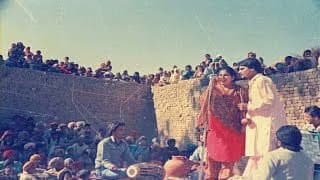 A screengrab of Amarjot Kaur and Amar Singh Chamkila in an akhada in Punjab. (Image: YouTube)
A screengrab of Amarjot Kaur and Amar Singh Chamkila in an akhada in Punjab. (Image: YouTube)
Amar Singh Chamkila was born on July 1, 1960 as Dhani Ram to Kartar Kaur and Hari Singh Sandila in an impoverished Dalit family in village Dugri, now a suburb in Ludhiana. As a six-year-old, he’d sing now and then at home and aspired to be an electrician when he grew up. At age 18, however, he landed a job at a cloth mill, and during his breaks, he would write songs as a pastime. By then, he was married to Gurmail Kaur, and had four children, two of whom survived, daughters Amandeep and Kamaldeep, who is also a Punjabi folk musician known as Kamal Chamkila.
During his days in the mill, he learnt to play the dholak and harmonium on the side, in the local drama groups which he joined at age 16 and where he honed his performative acts. He began attending music sessions and meeting local artistes. In one such meeting, his path crossed with the noted folk artiste Surinder Shinda and he chose him as his mentor. Chamkila wrote several songs for Shinda, set up his stage and sang in his chorus. Chamkila’s lyrics, perhaps, played a big role in Shinda’s fame. But Chamkila was unhappy with his remuneration. A mere Rs 100 a month, not enough to run a family. Chamkila decided to go it alone.
The making of a star: Amar Singh Chamkila
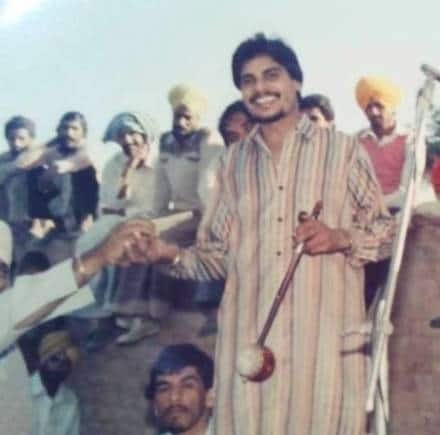 Amar Singh Chamkila. (Photo X)
Amar Singh Chamkila. (Photo X)
Dhani Ram, then, adopted the pseudonym: Amar Singh Chamkila. When Shinda was building his music career in faraway Canada, Chamkila cashed in on the chance to collaborate with Shinda’s singing partner Surinder Sonia, and together, he launched his first album of eight songs. The album Takue Te Takua Khadke (1979) took rural Punjabi music by a storm. The duo tasted massive success, however, despite being the songwriter and co-singer, Chamkila remained in the shadow of Sonia who, being the already established singer of the two, took home more money. She would get Rs 600 while he pocketed Rs 200. When Chamkila demanded equal pay, he was shown the door. The two, who sang 99 songs together, parted ways. Chamkila, then, partnered with Usha Kiran for some time before joining forces with Amarjot Kaur, who would go on to become his partner in music and life. Amarjot was a Jat or upper caste and their eventual inter-caste marriage ruffled feathers. Chamkila and Amarjot had a son together, named Jaiman Chamkila.
Chamkila-Amarjot: A partnership for the ages
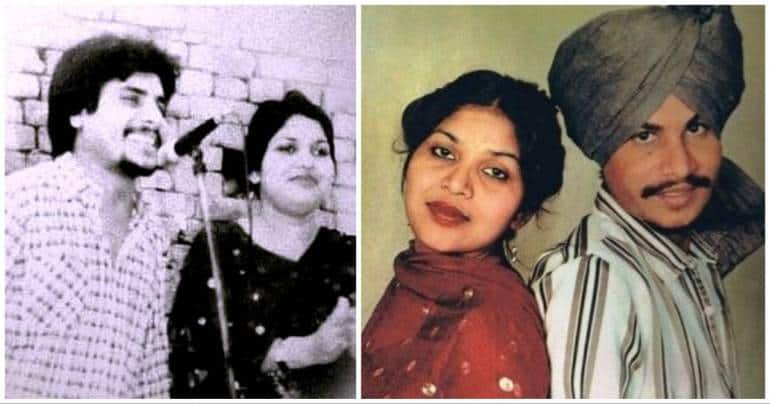 Amar Singh Chamkila and Amarjot Kaur. (Photo: X)
Amar Singh Chamkila and Amarjot Kaur. (Photo: X)
Amarjot, who left her first husband to pursue her musical aspirations, had worked with popular singer Kuldeep Manak before partnering with Chamkila. The two hit it off from the very first note. Their jugalbandi became iconic, almost as if they would be engaged in a musical tête-à-tête on stage. Crowds would pour in from near and far into the akhadas (free, open-air concerts), climb terraces and trees to hear them. Chamkila-Amarjot’s debut LP record, Bhul Gayi Main Ghund Kadna, featured an unforgettable track, Pahile Lalkare Naal Main Darr Gayi. Chamkila’s distinctive style and poignant lyrics resonated deeply with rural Punjabi audiences, solidifying his status as a musical icon.
Chamkila’s akhadas spread all over Punjab, rendering local singers jobless and angry. As the saying goes, he’d do 366 shows in 365 days a year. No wedding was complete without a Chamkila performance; if he wasn’t available, wedding dates would be changed. According to an Indian Express article, at a time folk singers charged Rs 500 for a show, Chamkila would demand Rs 4,000 for a wedding performance.
Chamkila with his trademark tumbi (an ektara-like one-stringed instrument) travelled to Canada and Dubai for shows and recorded for a number of films, even appeared in some as himself, including JP Pardesi’s Patola (translated as hot woman) in 1988, the year he was killed.
Chamkila and Amarjot’s duets became the talk of the town. Their bawdy lyrics struck a chord with listeners, young and old, in the rural parts. Unlike the sophistication of urban Punjabi artistes like Amrita Pritam, Sahir Ludhianvi, Shiv Kumar Batalvi, Avtar Pash, among others, or even the polished songs of Gurdas Maan. Chamkila’s voice was gravelly and raw and his bold lyrics had double-entendre suggestiveness, sexuality, male gaze and desire, social reality of extramarital affairs, drug abuse and alcoholism: subjects that other artistes would steer clear of or expressed in shrouded verse, Chamkila was out in the open with his songs, which revealed the dark, feudal underbelly of the post-Green Revolution Punjab. He also sang songs about the plight of the poor, of illicit relations, and about Sikh gurus like Baba Tera Nankana. The Ramdasiya singer, however, didn’t write or sing songs of or for the Dalits (Chamars), which several Dalit singers would do, a decade or so later. Chamkila became as mainstream as mainstream could get. He shaped the landscape of what would become Punjabi pop music. Even decades after he's gone, singers pay tribute to his lyrics by incorporating some of those into their songs, or perform his covers and record Chamkila's songs.
Music in the dark times
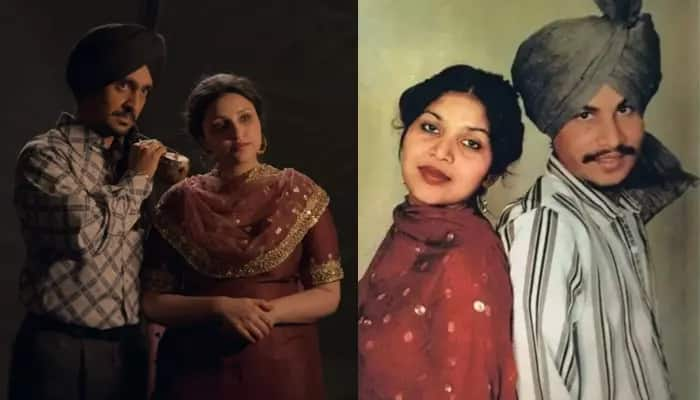 Parineeti Chopra and Diljit Dosanjh, respectively, in Imtiaz Ali's forthcoming biopic on the slain singer." width="700" height="400" /> The reel and real singing duo of Amarjot Kaur and Amar Singh Chamkila, to be played by (left) Parineeti Chopra and Diljit Dosanjh, respectively, in Imtiaz Ali's forthcoming biopic on the slain singer.
Parineeti Chopra and Diljit Dosanjh, respectively, in Imtiaz Ali's forthcoming biopic on the slain singer." width="700" height="400" /> The reel and real singing duo of Amarjot Kaur and Amar Singh Chamkila, to be played by (left) Parineeti Chopra and Diljit Dosanjh, respectively, in Imtiaz Ali's forthcoming biopic on the slain singer.
Several put the blame of Chamkila-Amarjot’s cold-blooded murders, like the murders of several Punjabi artists, on Khalistani militants. Those weren’t good times for artists, poets, writers and singers.
The backdrop to Chamkila’s music was Punjab’s insurgency, which gained momentum in the aftermath of the 1984 Sikh riots and continued till mid-1990s. The Sikh separatist movement, marked by terrorism, assassinations and police brutality, called for the establishment of Khalistan.
Chamkila’s lyrics was also considered vulgar by those who supported or were a part of then terrorist organisations. The book Terrorism in Punjab: Understanding Grassroots Reality (1999) recounts how, in April 1987, militants had laid down a 13-point code called Samaj Sudhar Lehar, putting down rules for how people should dress, interact and even marry. The boisterous Punjabi baraat was reduced to just 11 people and lehenga was a no-no for brides who were told to stick to salwar-kameez, an Indian Express article notes. Chamkila received anonymous death threats in the form of letters and would hide for days in his friends’ homes. He also stopped writing his suggestive songs for a while, but resumed soon after.
Who killed Chamkila?
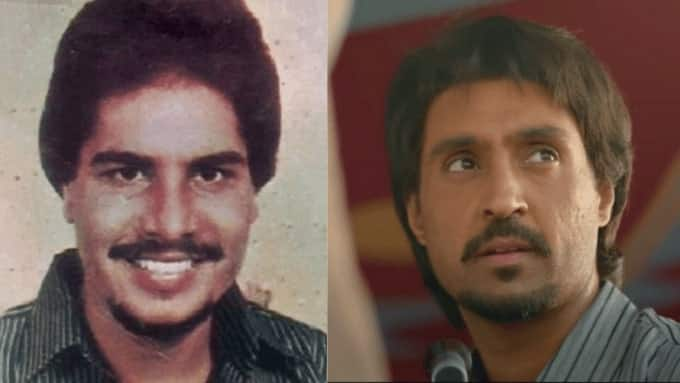 The real and reel Amar Singh Chamkila.
The real and reel Amar Singh Chamkila.
The year 1988 began on a bloody note, with the killing of peasant leader and Naxal poet-singer Jaimal Singh Padda, 45, who’d coined the slogan “Na Hindu raj, na Khalistan, raj karega mazdoor kisan (No Hindu state, no Khalistan — it’s the working class that will rule)”, according to an Indian Express article. He was gunned down outside his house near Kapurthala on March 18 that year. Five days later, Pash (born Avtar Singh Sandhu), 37, one of the most celebrated Punjabi poets, was shot down by militants.
While many blame the militancy for Chamkila-Amarjot’s deaths. Others conjecture that caste could have played a role in Chamkila (Dalit)-Amarjot’s (Jat) eventual assassination. There are conspiracy theories galore vis-à-vis the mystery behind the gunning down of Chamkila and Amarjot, along with two accompanists, by three disguised motorcyclists, when they were on their way to a live show in Mehsampur, near Jalandhar, on March 8, 1988. Chamkila was just 27 years old and at the peak of his singing career. No FIR was registered. And, till date, no arrests have been made. Yet, many others say that professional rivalry could have played a part in their death.
The killing of singer Sidhu Moosewala in 2022 rekindled old memories of the murder of Amar Singh Chamkila, who was, perhaps, the first superstar of Punjabi folk pop. Punjabi singers have for long attracted the ire of gangsters. Punjabi singer Navjot Singh alias Isapuria Virk was likewise murdered in Dera Bassi.
Punjabi writer Gulzar Singh Shaunki’s book Awaaz Nahi Mardi (2014) delves deeper into the life and times of Chamkila as the song Ishq Mitaye by composer AR Rahman, lyricist Irshad Kamil, and singer Mohit Chauhan, in Imtiaz Ali's forthcoming film, pays tribute to the life of the icon who went by the name of Chamkila.
Discover the latest Business News, Sensex, and Nifty updates. Obtain Personal Finance insights, tax queries, and expert opinions on Moneycontrol or download the Moneycontrol App to stay updated!